Introduction
Imagine stepping into your kitchen, plucking fresh basil for your homemade pasta or grabbing a sprig of lavender to steep in tea after a long day. An indoor herb garden isn’t just about fresh flavors—it’s about bringing wellness, beauty, and sustainability into your home.
Follow the face behind the hustle here!
For those who love natural living, holistic wellness, and self-care, growing your own herbs is an easy and rewarding way to connect with nature. Whether you have a small apartment or a spacious home, you can cultivate fresh, aromatic herbs that enhance your meals, improve air quality, and elevate your daily rituals.
In this guide, you’ll learn how to start an indoor herb garden, even if you’re a complete beginner. From selecting the right herbs to proper care techniques, this post will help you grow a thriving herb garden that supports your well-being.
1. Why an Indoor Herb Garden is a Wellness Essential
Indoor gardening is more than just a trend—it’s a lifestyle shift that benefits both your physical and mental well-being.
Health & Wellness Benefits:
- Fresh, Chemical-Free Herbs – Store-bought herbs often contain pesticides, while homegrown herbs are fresh and organic.
- Aromatherapy & Stress Relief – Herbs like lavender and mint provide natural relaxation and mental clarity.
- Improved Air Quality – Plants act as natural air purifiers, absorbing toxins and boosting oxygen levels.
- Nutrient-Rich Ingredients – Homegrown herbs contain more flavor and nutrients than dried or packaged alternatives.
Beyond health benefits, having fresh herbs at home adds beauty to your space, making your home feel more vibrant, green, and alive.
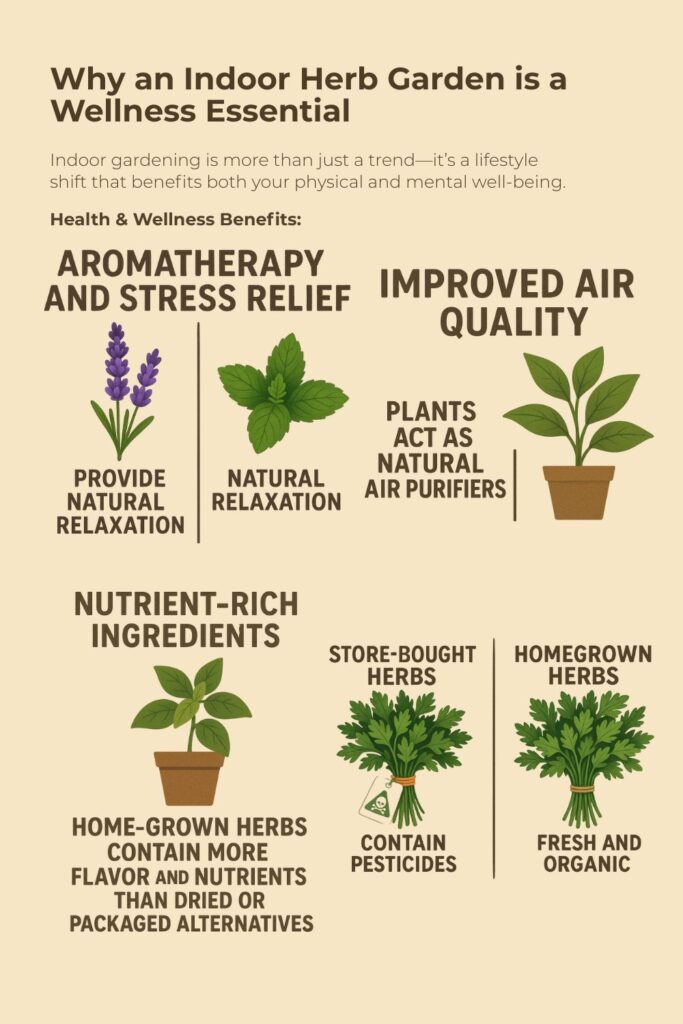
2. Best Herbs to Grow Indoors Year-Round
Not all herbs thrive indoors, but some adapt well to container gardening and limited sunlight. If you’re new to growing herbs, start with these low-maintenance herbs that grow indoors effortlessly.
Top Indoor Herbs for Beginners:
- Basil – Loves warmth and bright light; perfect for Italian dishes.
- Mint – Grows easily in low light; ideal for tea and refreshing drinks. Refreshing Your Life: The Incredible Benefits of Mint for Health and Home
- Parsley – A hardy herb that thrives in indirect sunlight.
- Thyme – A fragrant, drought-resistant herb with culinary and medicinal uses.
- Rosemary – Adds a woody, aromatic touch to dishes and thrives in dry conditions.
- Lavender – Known for its calming scent, great for teas and skincare.
- Chives – Easy to grow and perfect for garnishing dishes.
If you prefer herbs that thrive in winter, opt for mint, rosemary, and thyme, as they adapt well to cooler indoor temperatures.
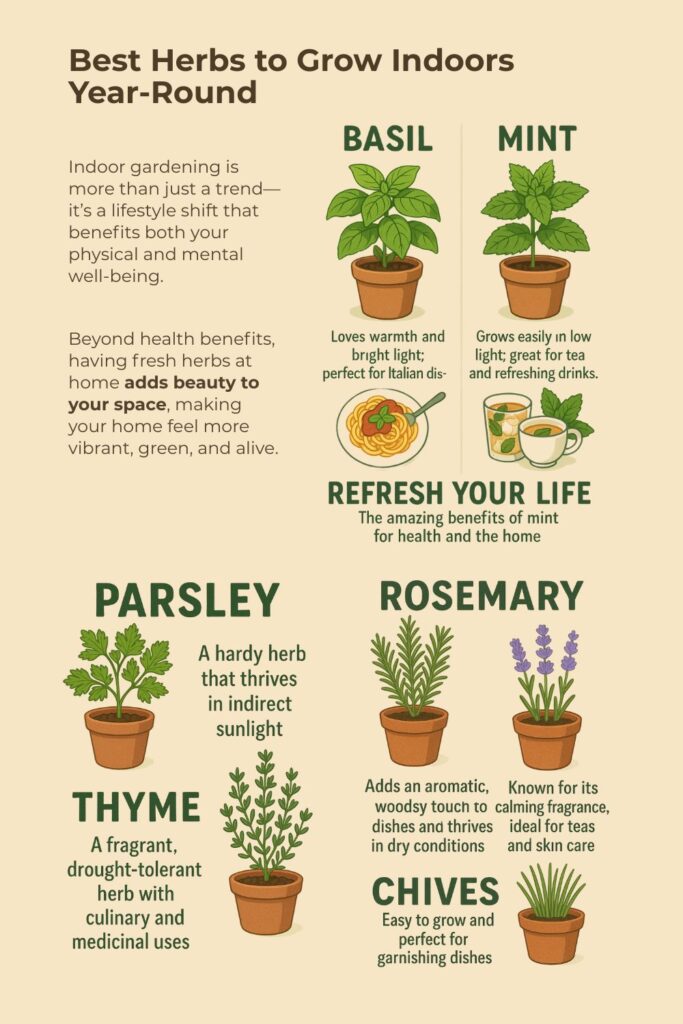
3. Choosing the Right Location for Your Indoor Herb Garden
Herbs need light, air circulation, and the right temperature to grow successfully. Whether you have a sunny kitchen windowsill or a small shelf, here’s how to create the perfect space.
Indoor Herb Garden Setup Tips:
- Sunlight Needs: Most herbs require 4-6 hours of sunlight per day. South or west-facing windows work best.
- Grow Lights for Low-Light Homes: If you don’t have enough natural light, use LED grow lights to keep your herbs healthy.
- Airflow: Good ventilation prevents mold and keeps herbs from wilting. Avoid placing herbs near radiators or drafty windows.
- Temperature: Keep herbs in a stable environment between 60-75°F (16-24°C).
If space is limited, consider vertical herb gardens, wall-mounted planters, or tiered plant stands to maximize growing space.
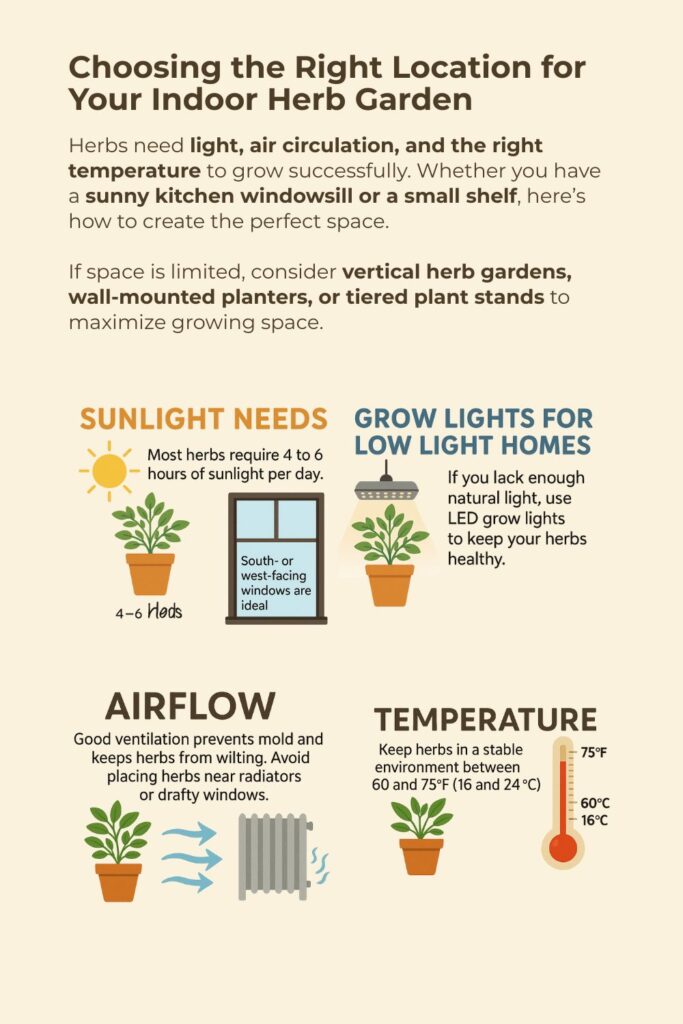
4. Choosing the Best Containers & Soil for Indoor Herbs
The right container and soil type will determine how well your herbs thrive indoors.
Best Containers for an Indoor Herb Garden:
- Terracotta Pots – Absorb moisture and prevent overwatering.
- Self-Watering Pots – Great for beginners who forget to water regularly.
- Hanging Planters – Save counter space and add beauty to your home.
- Mason Jars or Recycled Containers – Eco-friendly options for small herbs.
Best Soil for Indoor Herb Gardening:
Herbs grow best in light, well-draining soil. Use a potting mix designed for herbs or make your own by combining:
- 2 parts potting soil
- 1 part perlite (for drainage)
- 1 part compost (for nutrients)
Avoid heavy garden soil, as it retains too much moisture and can lead to root rot.
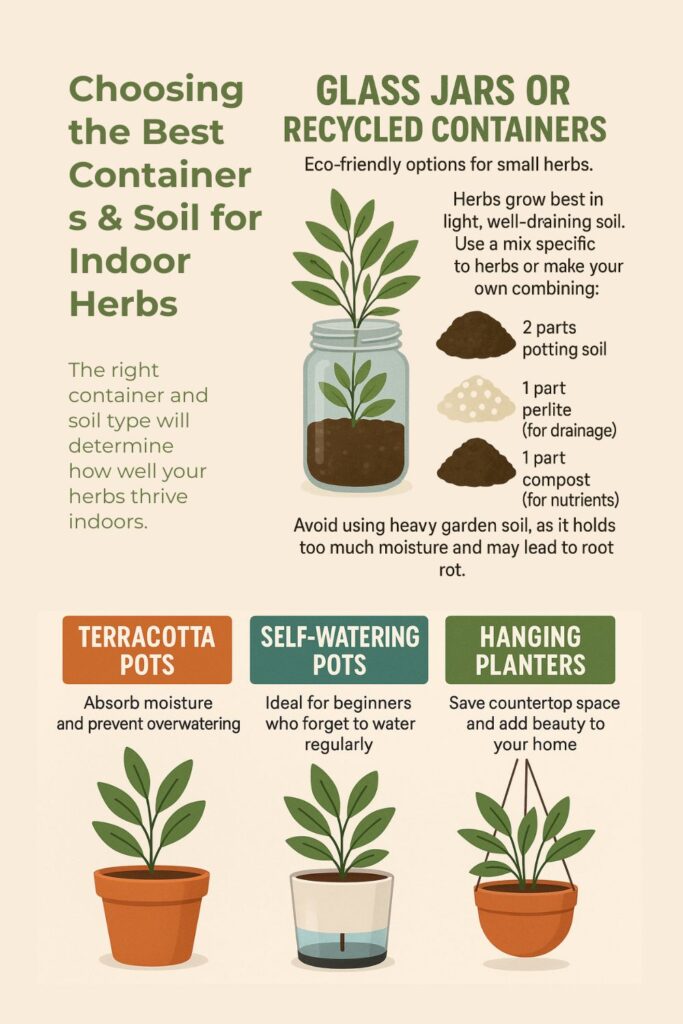
5. How to Water & Care for Your Indoor Herb Garden
Caring for indoor herbs is easy, but they do have specific needs. Overwatering is one of the most common mistakes beginners make.
Watering Tips:
- Water only when the soil feels dry to the touch (usually every 3-4 days).
- Use a pot with drainage holes to prevent root rot.
- Avoid watering directly on leaves—water the soil at the base of the plant.
Fertilizing & Maintenance:
- Use an organic fertilizer once a month to keep herbs growing strong.
- Prune regularly to encourage new growth and prevent herbs from becoming leggy.
- Remove dead leaves and flowers to keep plants healthy.
For year-round growth, consider rotating herbs under grow lights in the winter.
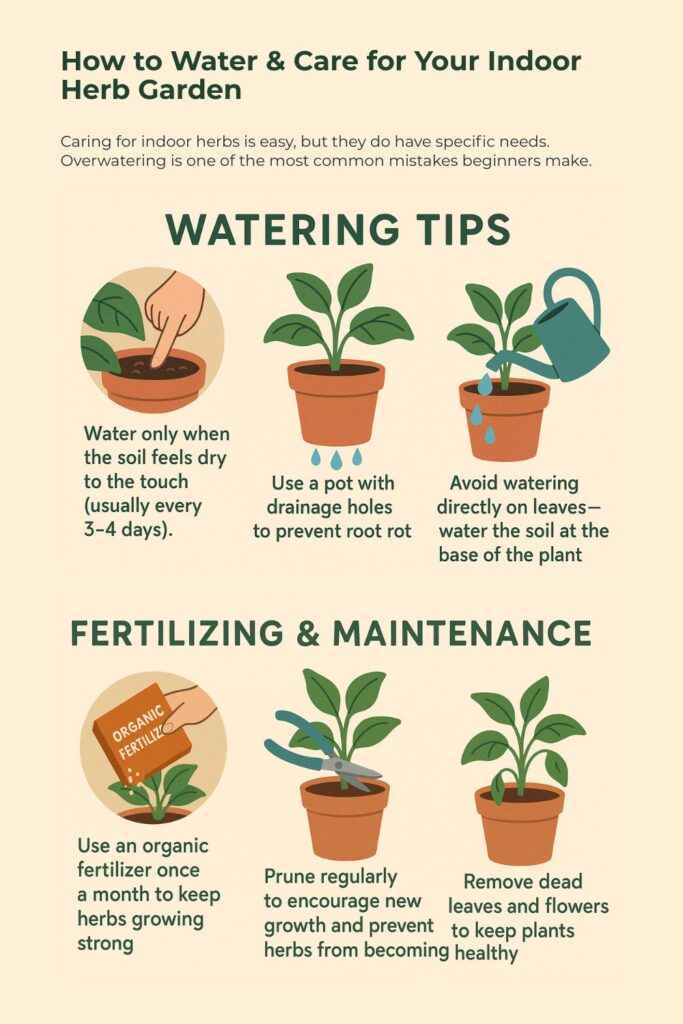
6. Common Problems & How to Fix Them
Even with the best care, indoor herbs can run into a few challenges.
Troubleshooting Indoor Herb Issues:
- Yellow leaves? You may be overwatering or lacking nutrients. Reduce watering and add organic compost.
- Leggy growth? Your herbs need more sunlight. Move them closer to a window or use grow lights.
- Fungus or mold? Improve air circulation and avoid misting the leaves.
If you see pests like aphids or spider mites, use a natural insecticidal soap or wipe leaves with diluted neem oil.
7. How to Use Fresh Herbs in Daily Life
Growing your own herbs isn’t just about having a beautiful indoor garden—it’s about enhancing your daily wellness routine.
Ways to Use Fresh Herbs:
- Cooking: Add fresh basil to pasta, rosemary to roasted veggies, or thyme to soups.
- Herbal Tea: Brew fresh mint, chamomile, or lavender for a calming tea.
- DIY Skincare: Infuse rosemary in face oils or create a refreshing lavender facial mist.
- Aromatherapy: Dry herbs and place them in sachets or homemade candles.
Conclusion
An indoor herb garden is one of the simplest ways to bring wellness into your home. Not only do fresh herbs enhance your meals and self-care rituals, but they also connect you to nature, improve your environment, and promote relaxation.
Whether you have a spacious kitchen or a small apartment, you can create a thriving indoor herb garden that brings beauty, flavor, and well-being into your everyday life. Start small, experiment with different herbs, and watch as your garden flourishes.
Articles you might want to read:
The Healing Power of Nature: How to Reconnect with the Natural World
Designing a Cozy Escape: The Art of Creating Mindful Spaces for Relaxation
